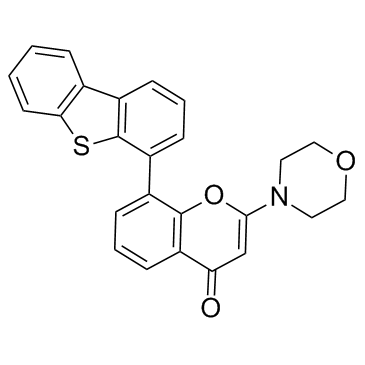NU7441 (KU-57788)
Modify Date: 2024-01-08 16:53:25

NU7441 (KU-57788) structure
|
Common Name | NU7441 (KU-57788) | ||
|---|---|---|---|---|
| CAS Number | 503468-95-9 | Molecular Weight | 413.488 | |
| Density | 1.4±0.1 g/cm3 | Boiling Point | 646.9±55.0 °C at 760 mmHg | |
| Molecular Formula | C25H19NO3S | Melting Point | 246.28° C | |
| MSDS | N/A | Flash Point | 345.0±31.5 °C | |
Use of NU7441 (KU-57788)KU-57788 is a potent and selective inhibitor of DNA-PK with an IC50 of 13 nM, with selectivity over a range of kinases including mTOR, PI 3-K, ATM and ATR. |
| Name | 8-dibenzothiophen-4-yl-2-morpholin-4-ylchromen-4-one |
|---|---|
| Synonym | More Synonyms |
| Description | KU-57788 is a potent and selective inhibitor of DNA-PK with an IC50 of 13 nM, with selectivity over a range of kinases including mTOR, PI 3-K, ATM and ATR. |
|---|---|
| Related Catalog | |
| Target |
DNA-PK:13 nM (IC50) CRISPR/Cas9 |
| In Vitro | NU7441 at non-toxic concentration of 0.3 μM induces radio-sensitization in non-small cell lung cancer cells irradiated with low-LET and high-LET radiation, and does not show double strand break-repair inhibition in irradiated cells. NU7441 (3 μM) shows significantly increased persistent γ-H2AX signals. NU7441 (0.3 μM) causes significant G2/M arrest and a remarkable increase of DNA fragmentation and enhances cellular senescence in irradiated H1299 cells[1]. NU7441 (0.5 to 10 µM) inhibits the growth of liver cancer HepG2 cells dose- and time-dependently. NU7441 reduces pDNA-PKcs (S2056) protein expression in liver cancer cells. Furthermore, double treatment of NU7441 and 60Coγ IR affects DNA damage repair[2]. NU7441 is solvent-exposed in BRD4, this inhibitor can be classified as a Type I BRD inhibitor[4]. NU7441 reduces the frequency of NHEJ while increasing the rate of HDR following Cas9-mediated DNA cleavage[5]. |
| In Vivo | lung cancer cells irradiated with low-LET and high-LET radiation, and does not show double strand break-repair inhibition in irradiated cells. KU-57788 (3 μM) shows significantly increased persistent γ-H2AX signals. KU-57788 (0.3 μM) causes significant G2/M arrest and a remarkable increase of DNA fragmentation and enhances cellular senescence in irradiated H1299 cells[1]. KU-57788 (0.5 to 10 µM) inhibits the growth of liver cancer HepG2 cells dose- and time-dependently. KU-57788 reduces pDNA-PKcs (S2056) protein expression in liver cancer cells. Furthermore, double treatment of KU-57788 and 60Coγ IR affects DNA damage repair[2]. KU-57788 weakly inhibits BRD4 and BRDT with IC50s of 1 μM and 3.5 μM, respectively. KU-57788 is solvent-exposed in BRD4, this inhibitor can be classified as a Type I BRD inhibitor[4]. KU-57788 reduces the frequency of NHEJ while increasing the rate of HDR following Cas9-mediated DNA cleavage[5]. |
| Kinase Assay | The inhibitory activities of compounds against BRD4-1 and BRDT-1 are assessed by DSF using a StepOnePlus Real-Time PCR system. Purified BRD4-1 (4 μM final concentration; 10 mM HEPES (pH7.5), 100 mM NaCl, and 1 mM DTT), and BRDT-1 (4 μM final concentration; 50 mM phosphate (pH7.4), 100 mM NaCl, and 1 mM DTT) are assayed, in quadruplicates, in a 96-well plate. Inhibitors are added to a final concentration of 100 μM and 2% DMSO. Protein Thermal Shift Dye (1:8000) is used as the fluorescent probe, and fluorescence is measured using the ROX Reporter channel (620 nm). Protein stability is investigated by programing the thermocycler to increase the temperature from 25 to 99°C using 0.2°C increments and 10 s incubations per increment. The inflection point of the transition curve/melting temperature (Tm) is calculated using the Boltzmann equation within the Protein Thermal Shift Software (v.1.1). JQ1(+) and dinaciclib are used as controls for strong and weak binders of BRD4-1, respectively. The ΔTm is calculated by using DMSO control wells as a reference. |
| Cell Assay | HepG2 cells (4000 per well) are cultured in a 96-well plate for 24 h. Once the cells complete the attachment, 0.1 µM, 1 µM, 5 µM, and 10 µM of KU-57788 are added to the culture media. After 12 h of KU-57788 treatment, 10% CCK-8 solution is added into the culture media, and the incubation continued for two h. OD450 values are determined by a spectrometer, and the results are analyzed to measure the cell growth. |
| References |
| Density | 1.4±0.1 g/cm3 |
|---|---|
| Boiling Point | 646.9±55.0 °C at 760 mmHg |
| Melting Point | 246.28° C |
| Molecular Formula | C25H19NO3S |
| Molecular Weight | 413.488 |
| Flash Point | 345.0±31.5 °C |
| Exact Mass | 413.108551 |
| PSA | 70.92000 |
| LogP | 5.98 |
| Vapour Pressure | 0.0±1.9 mmHg at 25°C |
| Index of Refraction | 1.732 |
| Storage condition | Store at +4°C |
| NU7441 |
| 4H-1-Benzopyran-4-one (8-(4-dibenzothienyl)-2-(4-morpholinyl) |
| 8-(Dibenzo[b,d]thiophen-4-yl)-2-(morpholin-4-yl)-4H-chromen-4-one |
| cc-207 |
| KU-57788 |
| 4H-1-Benzopyran-4-one, 8-(dibenzo[b,d]thien-4-yl)-2-(4-morpholinyl)- |
| 8-(Dibenzo[b,d]thiophen-4-yl)-2-(4-morpholinyl)-4H-chromen-4-one |
| 8-(dibenzo[b,d]thiophen-4-yl)-2-morpholino-4H-chromen-4-one |
| NU-7441 |